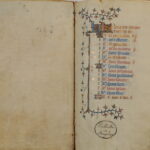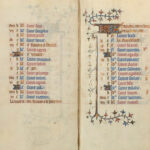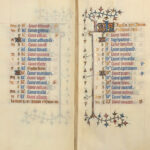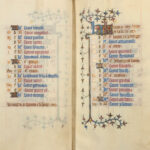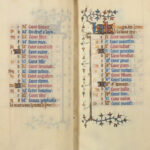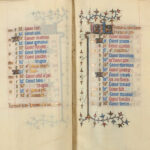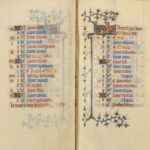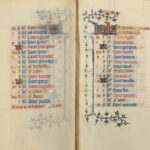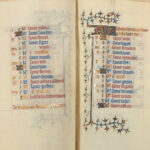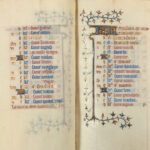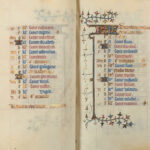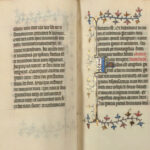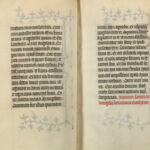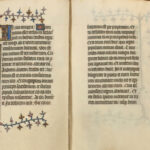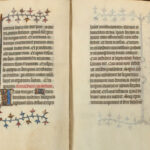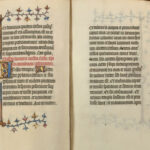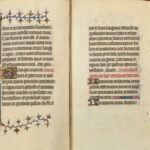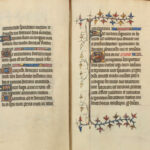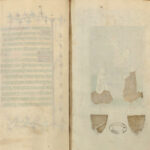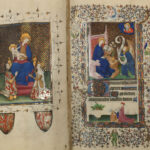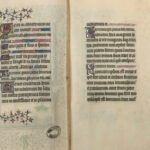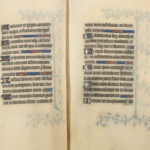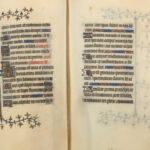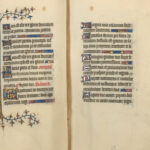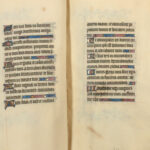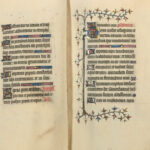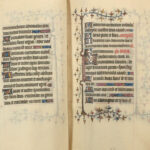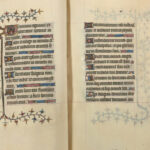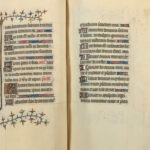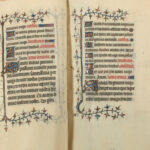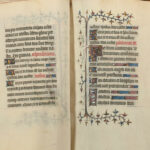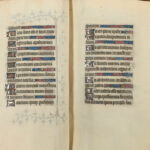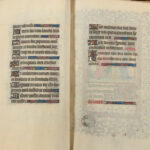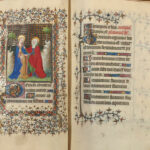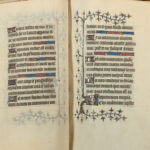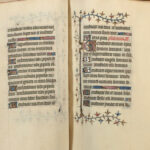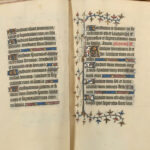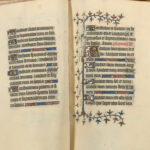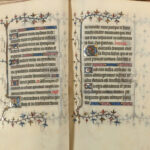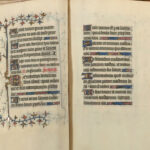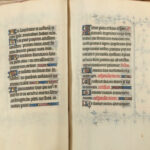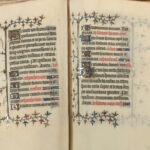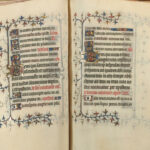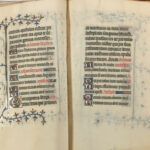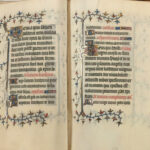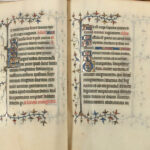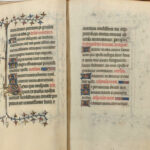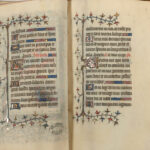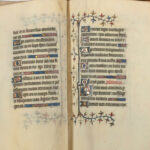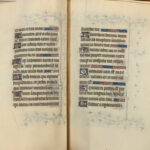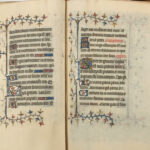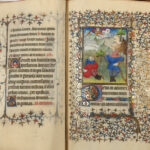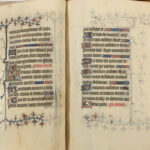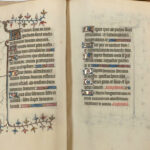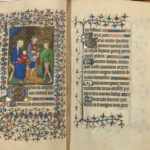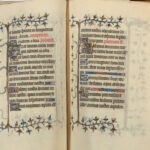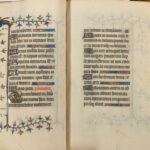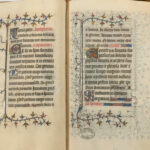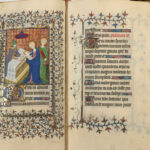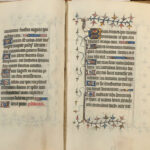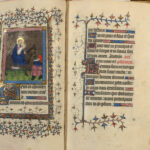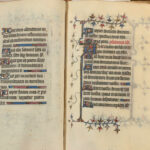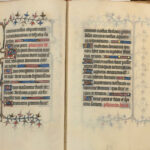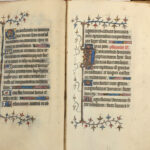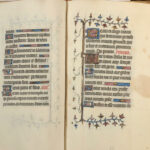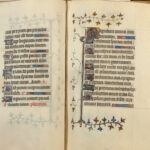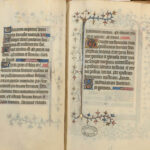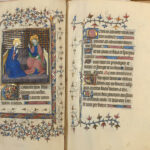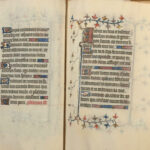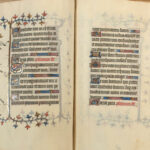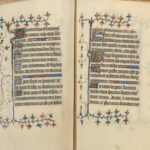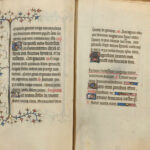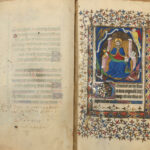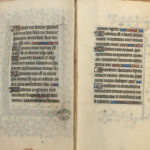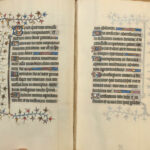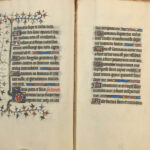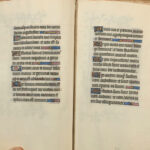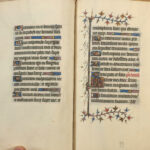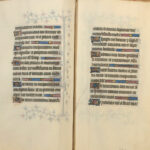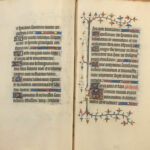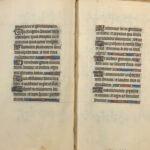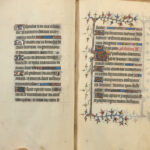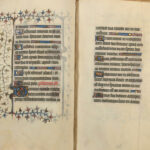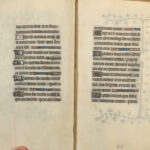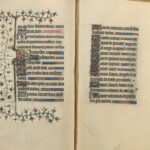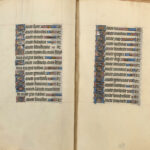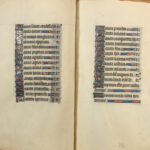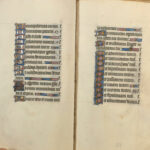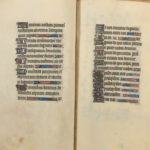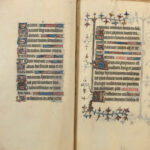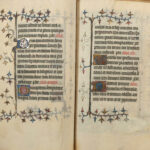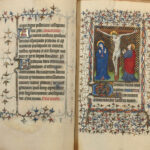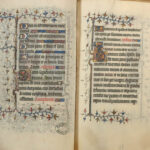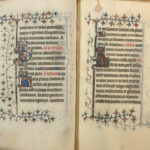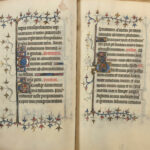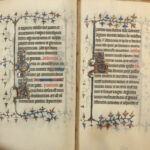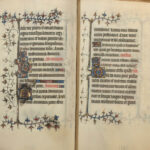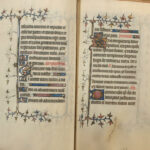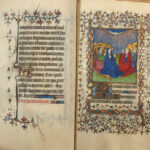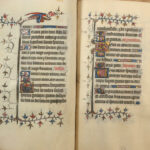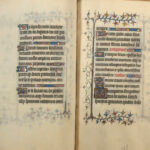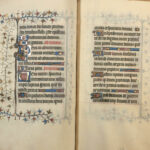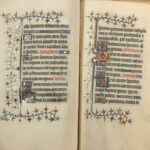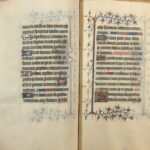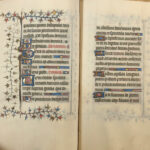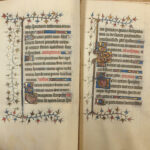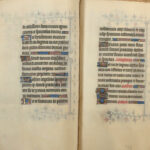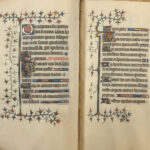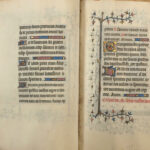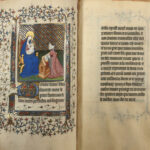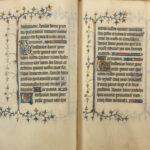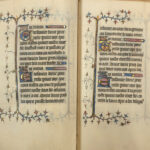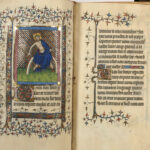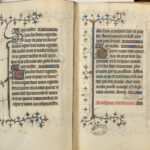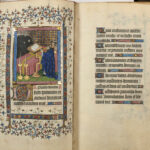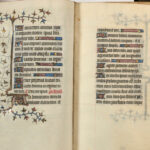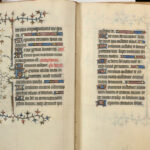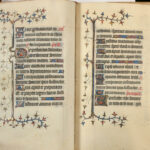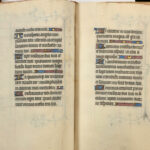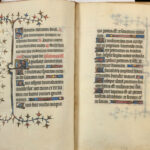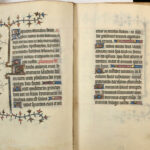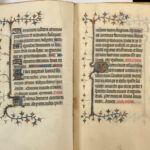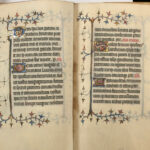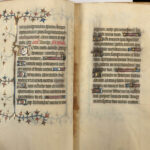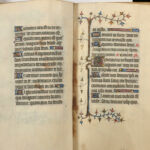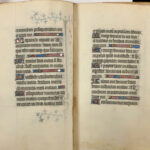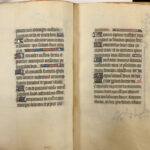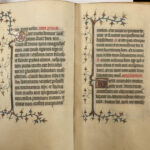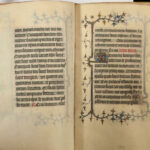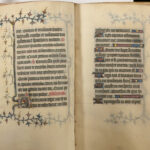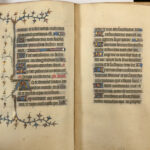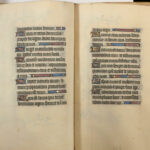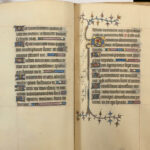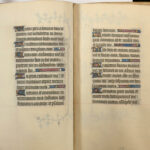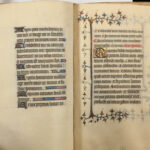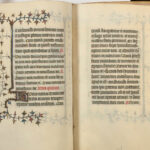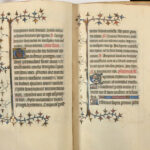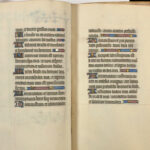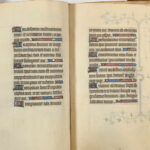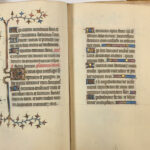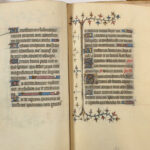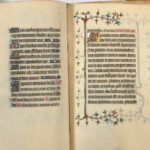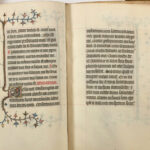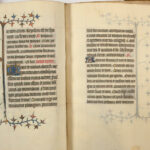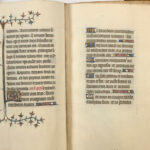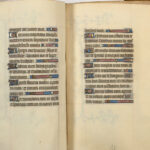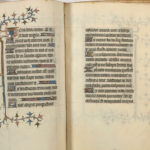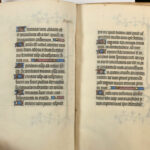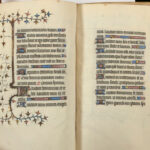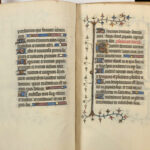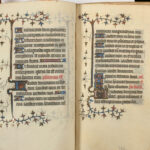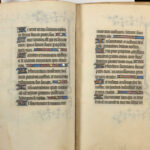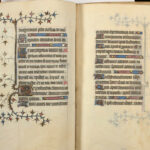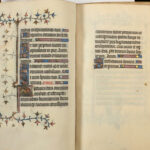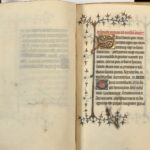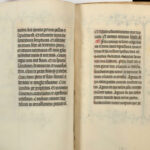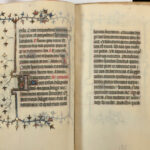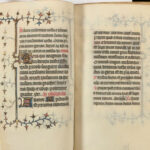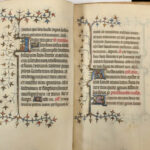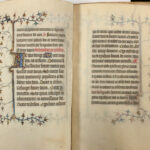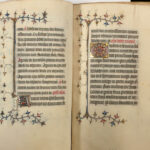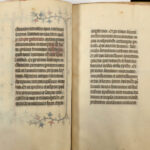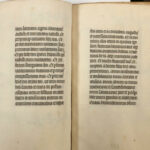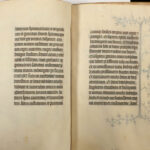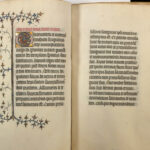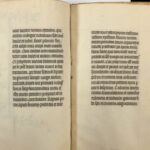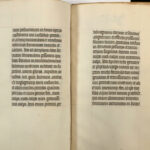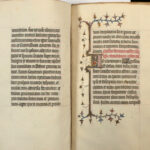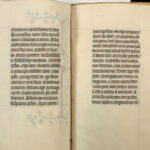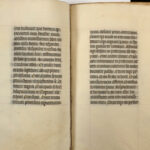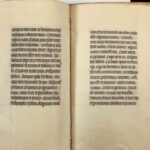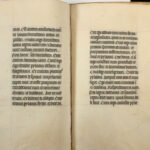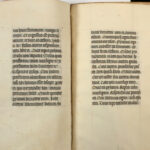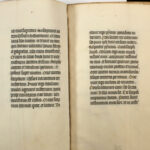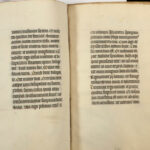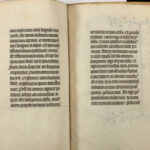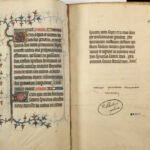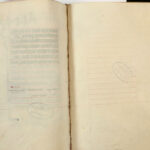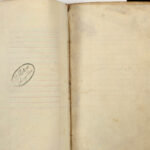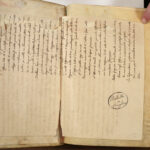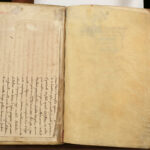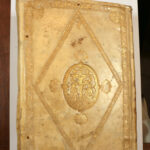Book of Hours Ms. 459
Angelica Library
Dated: Early 15th century
Author: Unknown in French literature
Folio measurements: 235×160 mm.
Genre: Book of prayers
Miniatures: Present
The Book of Hours (MS 459) is a compendium of devotional texts for use by the laity, modelled on the Breviary of the Clergy, the core of which was constituted by the Office of the Virgin. This Latin manuscript, on parchment, in French Gothic minuscule, was produced in France in the first half of the 15th century. It has been richly illustrated with 15 full-page miniatures with gilding. Books of Hours began to be widely distributed beginning in the middle of the 13th century. They then became extraordinarily popular in the 14th and 15th centuries, especially in France and the Low Countries, when collective prayer, uttered verbally and aloud, began to be replaced by prayer that was recited silently and was therefore more personal. Simply possessing one of these books was considered an assurance of protection, almost as if they were amulets to be carried about.
- History and Context
- Structure and Writing
- Iconography and Iconology
- Materials and Execution Techniques
- Censure and Modifications
- Preservation and Restoration
- Bibliography
Manuscript 459 held in the Angelica Library is a Book of Hours. That is to say, it is a compendium of devotional texts for use by the laity, modelled on the Breviary of the Clergy, the core of which was constituted by the Office of the Virgin.
The manuscript, of French origin, can be dated to the early 15th century.
The volume in the Angelica Library belongs to a widely attested book type. Indeed, many examples of books of hours have come down to us. Books of Hours began to be widely distributed beginning in the middle of the 13th century. They became extraordinarily popular in the 14th and 15th centuries, especially in France and the Low Countries, to such an extent that they were called the bestsellers of the Middle Ages, at least in these areas. Although modelled on the pattern of the Breviaries, the choice of texts and their arrangement in the Books of Hours responded to the specific choices of patrons and were in continuous transformation through additions, adaptations, updates sometimes in response to the wishes of new owners. for this type of book there was no set text nor any fixed or pre arranged textual variants over time.
Books of Hours were “miscellanies” of devotional texts. The identification of all the authors of the many commentaries, psalms, orations, etc. would also be difficult because their contents often varied from one copy to the next.
The miniatures found in the volume could be attributed to several artists, as demonstrated by the obvious stylistic, formal and compositional dissonances that can be gleaned by leafing through its folios. This is especially clear in the Virgin and Child with Patrons (ff. 21v-22r) and the remaining scenes. The illustration that introduces the Office of the Virgin shows a more refined craftsmanship, with a different compositional capacity, a greater volumetric rendering of the characters with their more precise physiognomic characterisation. According to certain proposals put forward by some scholars, this miniature could be the work of the Master of Luçon, an artist who became active in the final decade of the 14th century, and who would then become the main master of the Paris school.
The remainder, often displaying a certain clumsiness in their scenic construction, certain approximations in spatial layouts, and less skill in character rendering, were most likely the result of the collaboration of two personalities active in a different atelier. According to some scholars, it is likely that these latter miniatures belonged to the so-called Bedford Trend, i.e., miniaturists predating the Master of Bedford, who was also active in Paris. The illustrations in the Book of Hours, which can be ascribed to different personalities, were probably produced over the same period of years, despite the fact that the image of the patrons is depicted on a loose folio inserted between two quaternions.
The codex patrons have been identified as: Robert de Bossey, Knight of Normandy, connected to the French court, who died in 1415 during the Battle of Azincourt against Henry V of England, and his wife Roberte de Calleville, native of Rouen. The couple is depicted praying at the feet of the Virgin and Child on f. 21v, along with the coats of arms of their respective families. Because of their identification it was possible to shed light on the commissioning of the precious volume to then anchor its execution chronologically.
The extremely widespread use of the books of hours has been related to the evolution of reading habits in the Late Middle Ages, i.e., the shift from collective, oral prayer recited aloud to personal, silent devotions. These books were also believed to have an apotropaic function. Their mere possession was considered an assurance of protection, almost as if they were personal amulets to be carried about, regardless of whether or not the devotional texts they contained were being read.
There are no known relevant historical events related to its layout or its history more generally.
The extraordinary richness and refined craftsmanship of the decorations have engendered particular interest in the volume. In addition to these was the extensive use of gold to embellish every element of the ornamentation and many sections of the text.
The history of the codex is unknown. It is not known how it came to the Angelica Library.
Latin
This membranous codex is in a small format, measuring 184 x 14 mm, with the ruling in colour. The text was transcribed by a single copyist using a French Gothic minuscule script.
This codex was written in a transalpine environment by a copyist who adopted a French Gothic minuscule.
The offices and devotions contained in the volume would be recited privately at certain times of the day, in accordance with the canonical office found in the Breviary.
The manuscript presents a refined craftsmanship with a rich sequence of figurative scenes and ornamental elements.
The illustrative sections comprises 15 miniatures arranged in rectangular frames edged in gold coordinated with other colours. These miniatures mark the most significant text passages, offering its patrons prompts for individual meditation and celebration. In keeping with the figurative tradition of the Books of Hours, the most richly illuminated section of the text is that dedicated to the Office of the Virgin, illustrated with episodes from the childhood of Christ. Accompanying this section are the following scenes: the Virgin and Child with the patrons at prayer (f. 21v), the Annunciation (f. 22r), the Visitation (f. 41v), the Nativity (f. 62r), the Announcement to the Shepherds (f. 68r), the Adoration of the Magi (f. 72v), the Presentation in the Temple (f. 76v), the Flight into Egypt (f. 80v), and the Coronation of the Virgin (87v). The folios containing the Penitential Psalms are enriched by five illustrations: Christ enthroned among the symbols of the four evangelists (f. 94r), the Crucifixion (f. 116r), the Pentecost (f. 124r), the Virgin breastfeeding and the patron in prayer (f. 135v), and Christ the judge (f. 141v). Accompanying the Office of the Dead is a single miniature portraying a liturgical ceremony (f. 144v).
As in all Books of Hours, the illustrations in the Angelica Library exemplar are not representations of figurative transpositions of the facing texts therein, there is no correspondence between the texts and the images. The folios that contain the tabular miniature grotesques have their margins animated by a densely packed frame composed of slender, mostly spiral-shaped raceme illustrations, populated with fantastic shapes, birds, and human figures.
Multiple ornate initials were added to the illustrative cycle. Equally extensive was the use of line-endings that fill the space left empty at the ends of the lines of writing.
Like all books of hours, this volume, also held at the Angelica Library, was intended for its patrons’ devotion and their private recitation of offices and devotions according to the liturgy of the hours.
Robert de Bossey, Knight of Normandy, and his wife Roberte de Calleville, native of Rouen.
The canonical procedure for writing that was generally followed was as follows:
- The support was selected and prepared, in the case of the The Book of Hours MS 459, in parchment.
- The quire was constructed (4, 5 or 6 leaves folded and tucked inside of one another).
- The preparatory perforation was carried out.
- The ruling was then done, either dry or with coloured lead, according to a full-page or 2-column scheme. The The Book of Hours MS 459 has a full-page scheme and the ruling was inserted in colour.
- The work was copied, leaving space for initials and headings (i.e. accessory texts such as titles, contents, and the explicit).
- The parts in red were then inserted, i.e. the headings and any pen strokes on the capital letters (it was almost always the copyist himself who would do this).
- The miniaturist would draw in the initials, which could also extend into the margins.
- The illustrations could have been inserted into the spaces specifically reserved for the script. Or, if they occupied an entire page, this could be part of the quire, or the illustration could be executed on a single folio that was then inserted inside the quire. In this second case, when observing the structure of the quire, one would notice an oversized folio with half missing.
- Last, the quires were first sewn together and then sewn onto to the cover. This operation could have also taken place over a period of time.
The canonical procedure for the execution of a miniature prescribed that on the parchment that had been well-stretched and cleaned, the preparation would be laid out and the basic preparatory drawing would then be sketched in.
So one of the possible preparations for gilding, was Armenian clay, otherwise known as “bole” mixed with glue, until a perfectly homogenous base was obtained on which to apply gold leaf gilding. The colour of the bole influences the tone of the gilding to be applied. So, a red or a yellow bole could be used if a warmer or paler tone was desired respectively. This layer of clay would be applied with a soft brush. Very fine gold leaves would then be applied to the bole. The gold leaf would then be burnished with agate stone until it gleamed. Gilding could also be applied with a brush. Then finally, the colours with which the backgrounds and figures were to be painted would be prepared.
Once the main shapes and figures were composed, other decorations and ornaments could be drawn: the rinceaux in the margins and the ornate initials, and then the historiated initials. The order of execution of these elements could vary. These ornaments are partially present in MS 1102. The miniature would first be left to dry and in the end it would be transferred to the person who was to assemble the quire.
The extensive use of gold in almost all illuminated manuscripts is remarkable.
To respond, it would be necessary to conduct a textual and codicological study of the entire volume. For example, see f. 21, where the patrons are portrayed in prayer. This must have been a loose folio added at a later date. When? Was it at the same time or was it just a little later? Is it and indication of a change of ownership? From a formal stylistic standpoint, this miniature differs from the others. However, this element alone tells us little, since the most important miniature(s) would often be executed by the most gifted miniaturist.
This information is not available.
Analyses were carried out on the cover (the spine, interior, and front cover) and on three folios, which confirm that the state of preservation is excellent.
As part of the Codex 4D project, thermographic and reflectographic surveys were conducted in the mid-IR, (3-5 µm spectral range). These are imaging techniques that allow structural and/or subsurface elements of both the ligatures and the miniatures to be visualised.
Three swabs for microbiological analyses were taken on the cover and three on the folios, which were then processed in the laboratory using Sanger sequencing. Sponge sampling for chemical analyses was performed on folio 85, followed by HPLC and FT-IR analyses.
For the Book of Hours, reflectographs in the mid-IR were mainly used to align RGB images with thermographic images so that a 3D representation in the IR could be created. Thermography was used to study some of the miniatures. This method revealed some useful information on the state of adhesion of the gilding (no sub-surface detachments extending from small gaps that were visible).
Both methods showed some elements of the preparatory drawing with greater contrast. Thermographic investigations carried out on f. 21v revealed a small pentimento at the head of the patron Robert de Bossey II, Knight of Normandy, depicted praying at the feet of the Virgin and Child on f. 21v. The thermograms show that the figure was originally made with a headdress, which is no longer present in the current version of the miniature.
From the microbiological analyses, on the front cut and back of the cover, the areas most handled by users, gram positive bacteria belonging to actinobacteria, commonly found in soil, dust, skin and the human upper respiratory tract, were grown in the laboratory. For details on the analyses, see the pertinent annotations on the model.
The chemical analyses carried out on page 85 revealed a good state of preservation of the page support, comparable to that of the other pages of the book, with no peculiarities regarding the nature of the red stain.
- Enrico Narducci, Catalogus codicum manuscriptorum praeter graecos et orientales in Bibliotheca Angelica olim Cenobi Sancti Augustini de Urbe, Romae, Typis Ludovici Cecchini, 1893, tomo I, p. 210.
- A. Luciani, La miniatura e la prossima esposizione d'arte antica a Roma, in "La nuova antologia" s.2, 37, 1833, pp. 316-318.
- R. Amiet, Inventaire des manuscrits liturgiques conservés dans le bibliothèques et les archives de Rome, in "Scriptorium" 39, 1985, pp. 109-118, in part. 112.
- R. Amiet, Catalogue des livres liturgiques manuscrits dans les archives et les bibliothèques de la Ville de Rome, in "Studi medievali" 27, 1986, pp. 925-997, in part. 939.
- M. Cavalli - F. Terlizzi, Legature di pregio in Angelica. Secoli XV-XVIII, con il contributo di F. Cossu, Roma 1991, pp. 82-83.
- P. Coccia Desogus, Un Libro d'Ore francese nella Biblioteca Angelica di Roma, in "Miniatura" 5-6, 1993-1996, pp. 17-26.
- Maria. Vergine Madre Regina: le miniature medievali e rinascimentali, Roma, Biblioteca Vallicelliana, dicembre 2000-febbraio 2001, a cura di C. Leonardi - A. Degli Innocenti, Milano 2000.


